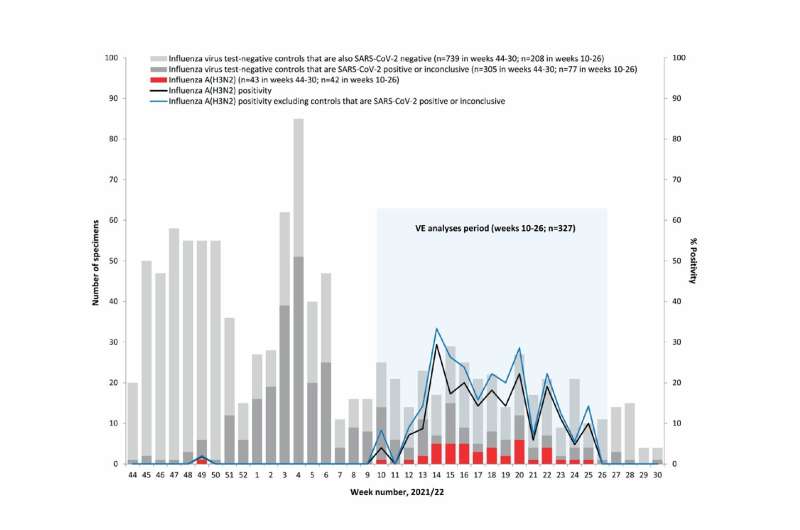Unusual late influenza spring-wave in Canada 2022

In a Eurosurveillance paper, researchers look into the impact of COVID-19 measures on influenza circulation in Canada between 2020 and 2022 and the vaccine effectiveness against late-season influenza illness due to A(H3N2) in 2022.
Early in the COVID-19 pandemic, the circulation of influenza virus stopped in Canada, as a result from the implementation of public health measures against COVID-19 e.g. physical distancing and wearing masks. In spring 2022, when these measures were relaxed, influenza virus re-emerged.
Vaccine effectiveness against late-season influenza
VE analyses were done using a test-negative design including nasal or nasopharyngeal specimens. The analyses included test results from patients older than 1 year, within 7 days of acute onset of influenza-like illness in community-based clinics or COVID-19 sites in the Canadian provinces of Alberta, British Columbia, and Ontario.
Among the 327 eligible specimens collected during the analysis period, 13% tested positive for influenza A(H3N2). All belonged to the clade 3C.2a1b.2a.2 considered antigenically different from the A(H3N2) 3C.2a1b.2a.1 strain in the 2021/22 influenza vaccine. However, the influenza A(H3N2) clade found in Canada was similar to that in the vaccine for the upcoming northern hemisphere 2022/23 season.
Study results support composition decision for 2022/23 influenza vaccine
Adjusted (age group, province, comorbidity and calendar month) VE against influenza A(H3N2) was 36% (95% confidence interval -38 to 71) in the three Canadian provinces. The authors note that the "confidence intervals around our VE estimates are wide and we cannot rule out an interpretation of no protection. However, point estimates remain the most likely findings."
Additionally, the results are comparable to 2021/22 VE estimates against influenza A(H3N2) reported from the United States and from Europe [2,3]. Authors also highlight that "despite mismatch of the vaccine clade 3C.2a1b.2a.1 strain against the circulating clade 3C.2a1b.2a.2 viruses and an unusually long time since vaccination, the Canadian SPSN shows that the 2021/22 vaccine reduced the risk of medically attended influenza A(H3N2) illness by about one third during the late spring wave."
Finally, based on their analysis, the authors conclude that "the findings reinforce the World Health Organization's decision to switch to a clade 3C.2a1b.2a.2 strain for the northern hemisphere 2022/23 vaccine."
More information: Shinhye Kim et al, Influenza vaccine effectiveness against A(H3N2) during the delayed 2021/22 epidemic in Canada, Eurosurveillance (2022). DOI: 10.2807/1560-7917.ES.2022.27.38.2200720




















